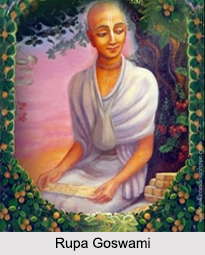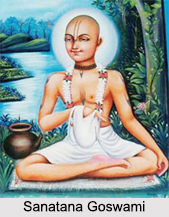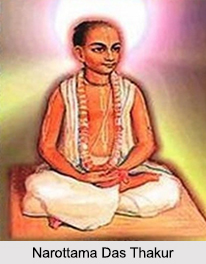 The contemporary concept of Vaishnavism in India is called Gaudiya Vaishnava, which was formed for three centuries following the disappearance of Sri Chaitanya Mahaprabhu. In earlier traditions, followers of Chaitanya Mahaprabhu, Nityananda Prabhu and Advaita Acharya educated and initiated people in their own regions across Bengal. Chaitanya Mahaprabhu requested to select few among his followers, who later came to be known as the Six Gosvamis of Vrinadavan. They would represent Mahaprabhu"s theology and ideology of Bhakti through their writings. This theology focused on the relationship between devotees and Radha-Krishna; and Chaitanya Mahaprabhu has been symbolized as the embodiment of both Radha-Krishna.
The contemporary concept of Vaishnavism in India is called Gaudiya Vaishnava, which was formed for three centuries following the disappearance of Sri Chaitanya Mahaprabhu. In earlier traditions, followers of Chaitanya Mahaprabhu, Nityananda Prabhu and Advaita Acharya educated and initiated people in their own regions across Bengal. Chaitanya Mahaprabhu requested to select few among his followers, who later came to be known as the Six Gosvamis of Vrinadavan. They would represent Mahaprabhu"s theology and ideology of Bhakti through their writings. This theology focused on the relationship between devotees and Radha-Krishna; and Chaitanya Mahaprabhu has been symbolized as the embodiment of both Radha-Krishna.
Followers of Vaishnava
The six followers of Vaishnava were Rupa Goswami, Sanatana Goswami, Gopala Bhatta Goswami, Raghunatha Bhatta Goswami, Raghunatha dasa Goswami and Jiva Goswami. In the second generation of this tradition, Narottama, Srinivasa and Shyamananda, three students of Jiva Goswami further spread the theology across Bengal and Odisha.
 Rupa Goswami: Rupa Goswami was a spiritual teacher or guru, poet, and philosopher of the Gaudiya Vaishnava tradition. With his brother Sanatana Goswami, he is considered to be the most senior of the six Goswamis of Vrindavan associated with Caitanya Mahaprabhu.
Rupa Goswami: Rupa Goswami was a spiritual teacher or guru, poet, and philosopher of the Gaudiya Vaishnava tradition. With his brother Sanatana Goswami, he is considered to be the most senior of the six Goswamis of Vrindavan associated with Caitanya Mahaprabhu.
Rupa Goswami: Rupa Goswami was a spiritual teacher or guru, poet, and philosopher of the Gaudiya Vaishnava tradition. With his brother Sanatana Goswami, he is considered to be the most senior of the six Goswamis of Vrindavan associated with Caitanya Mahaprabhu.
Sanatana Goswami: Sanatana Goswami was a principal disciple of Chaitanya Mahaprabhu. He wrote a number of important works in the "Bhakti" tradition of Gaudiya Vaishnavism and was the senior most of the influential Six Goswamis of Vrindavan.
Gopala Bhatta Goswami: Gopala Bhatta Goswami is one of the foremost disciples of Chaitanya Mahaprabhu, and a leading historical figure in the Gaudiya Vaishnava school of Hinduism. Being one of the six Goswami followers of Gaudiya Vaishnava tradition, he established the philosophical basis of the tradition influentially in formalised writings.
Raghunatha Bhatta Goswami: He is regarded in the Gaudiya tradition as an ideal practitioner of the Bhakti yoga system. After his death, his disciples built a temple for Sri Gaura Govinda in Vrindavana. He is offered respect as a guru by all of the current lineages of the Gaudiya Vaishnava tradition.
Raghunatha Dasa Goswami: Also known as Dasa Goswami, Raghunatha Dasa was renowned for his qualities of simplicity and renunciation. He led a life of extreme devotional practice, spending more than 22 hours out of every 24 chanting the "Hare Krishna" Maha mantra.
 Jiva Goswami: Jiva Goswami was a Hindu philosopher and saint from the Gaudiya Vaishnava school of Vedanta tradition. He produced a number of philosophical works on the theology and practice of Bhakti yoga, Vaishnava Vedanta and associated disciplines. He was the nephew of the two leading members of the Six Goswamis of Vrindavan- Rupa Goswami and Sanatana Goswami.
Jiva Goswami: Jiva Goswami was a Hindu philosopher and saint from the Gaudiya Vaishnava school of Vedanta tradition. He produced a number of philosophical works on the theology and practice of Bhakti yoga, Vaishnava Vedanta and associated disciplines. He was the nephew of the two leading members of the Six Goswamis of Vrindavan- Rupa Goswami and Sanatana Goswami.
Second Generation Followers of Gaudiya Vaishnava
In the second generation, students of Jiva Goswami named Narottama, Srinivasa and Shyamananda further preached the theology of the Gaudiya Vaishnav tradition. Their preaching further spread across the states of West Bengal and Odisha.
Narottama: Srila Narottama Das Thakur was asked to preach the message of Chaitanya Mahaprabhu further by Jiva Goswami, under whose guidance he was studying the Goswami scriptures. Five years after the disappearance of Chaitanya Mahaprabhu, Narottama organized annual festivals in Bengal, which further served to keep the Gaudiya philosophy spreading. He is best known for his devotional poetry, which describes his emotionally intense feelings towards Radha and Krishna. His prayers "Sri Rupa Manjari Pada" and "Sri Guru Charana Padma" are still sung in Gaudiya Maths and ISKCON temples on a regular basis.
Srinivasa: Srinivasa Achrya Thakur was a famous Vaishnava guru, the pupil of Jiva Goswami and teacher of Yadunandana Dasa and Radhavallabha Dasa. He converted King Bir Hambir to Vaishnava. His daughter, Hemalata Thakurani, was also a guru. Srinivas Acharya is a Parsada; he is the abhinna kalevara or identical body of Sri Chaitanya Mahaprabhu. Being one of the followers of Gaudiya Tradition, he further carried out the works of spreading the message of Vaishnavism.
Shyamananda: Shri Shyamananda Prabhu was born in Utkala (Medinipur at present). He was one of the disciples of Jiva Goswami, under whose guidance he studied the Goswami scriptures.









